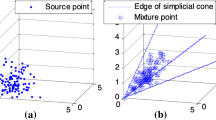Abstract
Given a set of mixtures, blind source separation attempts to retrieve the source signals without or with very little information of the mixing process. We present a geometric approach for blind separation of nonnegative linear mixtures termed facet component analysis. The approach is based on facet identification of the underlying cone structure of the data. Earlier works focus on recovering the cone by locating its vertices (vertex component analysis) based on a mutual sparsity condition which requires each source signal to possess a stand-alone peak in its spectrum. We formulate alternative conditions so that enough data points fall on the facets of a cone instead of accumulating around the vertices. To find a regime of unique solvability, we make use of both geometric and density properties of the data points and develop an efficient facet identification method by combining data classification and linear regression. For noisy data, total variation technique may be employed. We show computational results on nuclear magnetic resonance spectroscopic data to substantiate our method.













Similar content being viewed by others
References
Boardman, J.: Automated spectral unmixing of AVRIS data using convex geometry concepts. In: Summaries of the IV Annual JPL Airborne Geoscience Workshop, JPL Pub. 93–26, 1, 11–14 (1993)
Bobin, J., Starck, J.-L., Fadili, J., Moudden, Y.: Sparsity and morphological diversity in blind source separation. IEEE Trans. Image Process. 16, 2662–2674 (2007)
Bofill, P., Zibulevsky, M.: Underdetermined blind source separation using sparse representations. Signal Process. 81, 2353–2362 (2001)
Chambolle, A.: An algorithm for total variation minimization and applications. J. Math. Imaging Vis. 20, 89–97 (2004)
Chang, C.I. (ed.): Hyperspectral Data Exploitation: Theory and Applications. Wiley-Interscience, Hoboken (2007)
Choi, S., Cichocki, A., Park, H., Lee, S.: Blind source separation and independent component analysis: a review. Neural Inf. Process. Lett. Rev. 6, 1–57 (2005)
Cichocki, A., Amari, S.: Adaptive Blind Signal and Image Processing: Learning Algorithms and Applications. John Wiley and Sons, New York (2005)
Comon, P.: Independent component analysis-a new concept? Signal Process. 36, 287–314 (1994)
Ernst, R., Bodenhausen, G., Wokaun, A.: Principles of Nuclear Magnetic Resonance in One and Two Dimensions. Oxford University Press, Oxford (1987)
Guo, Z., Osher, S.: Template matching via \(\ell _1\) minimization and its application to hyperspectral target detection. Inverse Probl. Imaging 5, 19–35 (2011)
Hoyer, P.: Non-negative matrix factorization with sparseness constraints. J. Mach. Learn. Res. 5, 1457–1469 (2004)
Hyvärinen, A., Karhunen, J., Oja, E.: Independent Component Analysis. John Wiley and Sons, New York (2001)
Klingenberg, B., Curry, J., Dougherty, A.: Non-negative matrix factorization: Ill-posedness and a geometric algorithm. Pattern Recognit. 42, 918–928 (2009)
Liu, J., Xin, J., Qi, Y.-Y.: A dynamic algorithm for blind separation of convolutive sound mixtures. Neurocomputing 72, 521–532 (2008)
Liu, J., Xin, J., Qi, Y.-Y.: A soft-constrained dynamic iterative method of blind source separation. SIAM J. Multiscale Model. Simul. 7, 1795–1810 (2009)
Liu, J., Xin, J., Qi, Y.-Y., Zeng, F.-G.: A time domain algorithm for blind separation of convolutive sound mixtures and \(\ell _1\) constrained minimization of cross correlations. Comm. Math. Sci. 7(1), 109–128 (2009)
McDonnell, M.: Box-filtering techniques. Comput. Graph. Image Process. 17, 65–70 (1981)
Motzkin, T., Raiffa, H., Thompson, G., Thrall, R.J.: The Double Description Method. Annals of Math Studies, Vol. 8, Princeton University Press, pp. 51–73 (1953)
Naanaa, W., Nuzillard, J.-M.: Blind source separation of positive and partially correlated data. Signal Process. 85(9), 1711–1722 (2005)
Naanaa, W.: A Geometric Approach to Blind Separation of Nonnegative and Dependent Source Signals. 18th European Signal Processing Conference (EUSIPCO-2010), Aalborg, Denmark, August 23–27, pp. 747–750 (2010)
Nascimento, J.M.P., Bioucas-Diasm, J.M.: Vertex component analysis: a fast algorithm to unmix hyperspectral data. IEEE Trans. Geosci. Remote Sens. 43(4), 898–910 (2005)
Sun, Y., Ridge, C., del Rio, F., Shaka, A.J., Xin, J.: Postprocessing and sparse blind source separation of positive and partially overlapped data. Signal Process. 91(8), 1838–1851 (2011)
Sun, Y., Xin, J.: Under-determined sparse blind source separation of nonnegative and partially overlapped data. SIAM J. Sci. Comput. 33(4), 2063–2094 (2011)
Sun, Y., Xin, J.: A recursive sparse blind source separation method and its application to correlated data in NMR spectroscopy of bio-fluids. J. Sci. Comput. 51, 733–753 (2012)
Sun, Y., Xin, J.: Nonnegative sparse blind source separation for NMR spectroscopy by data clustering, model reduction, and \(\ell _1\) minimization. SIAM J. Imaging Sci. 5(3), 886–911 (2012)
Winter, M.E.: N-findr: an algorithm for fast autonomous spectral endmember determination in hyperspectral data. Proc. SPIE 3753, 266–275 (1999)
Rudin, L., Osher, S., Fatemi, E.: Nonlinear total variation based noise removal algorithms. Physica D 60, 259–268 (1992)
Acknowledgments
The work was partially supported by NSF-ATD grants DMS-0911277 and DMS-122507.
Author information
Authors and Affiliations
Corresponding author
Rights and permissions
About this article
Cite this article
Yin, P., Sun, Y. & Xin, J. A geometric blind source separation method based on facet component analysis. SIViP 10, 19–28 (2016). https://doi.org/10.1007/s11760-014-0696-6
Received:
Revised:
Accepted:
Published:
Issue Date:
DOI: https://doi.org/10.1007/s11760-014-0696-6




